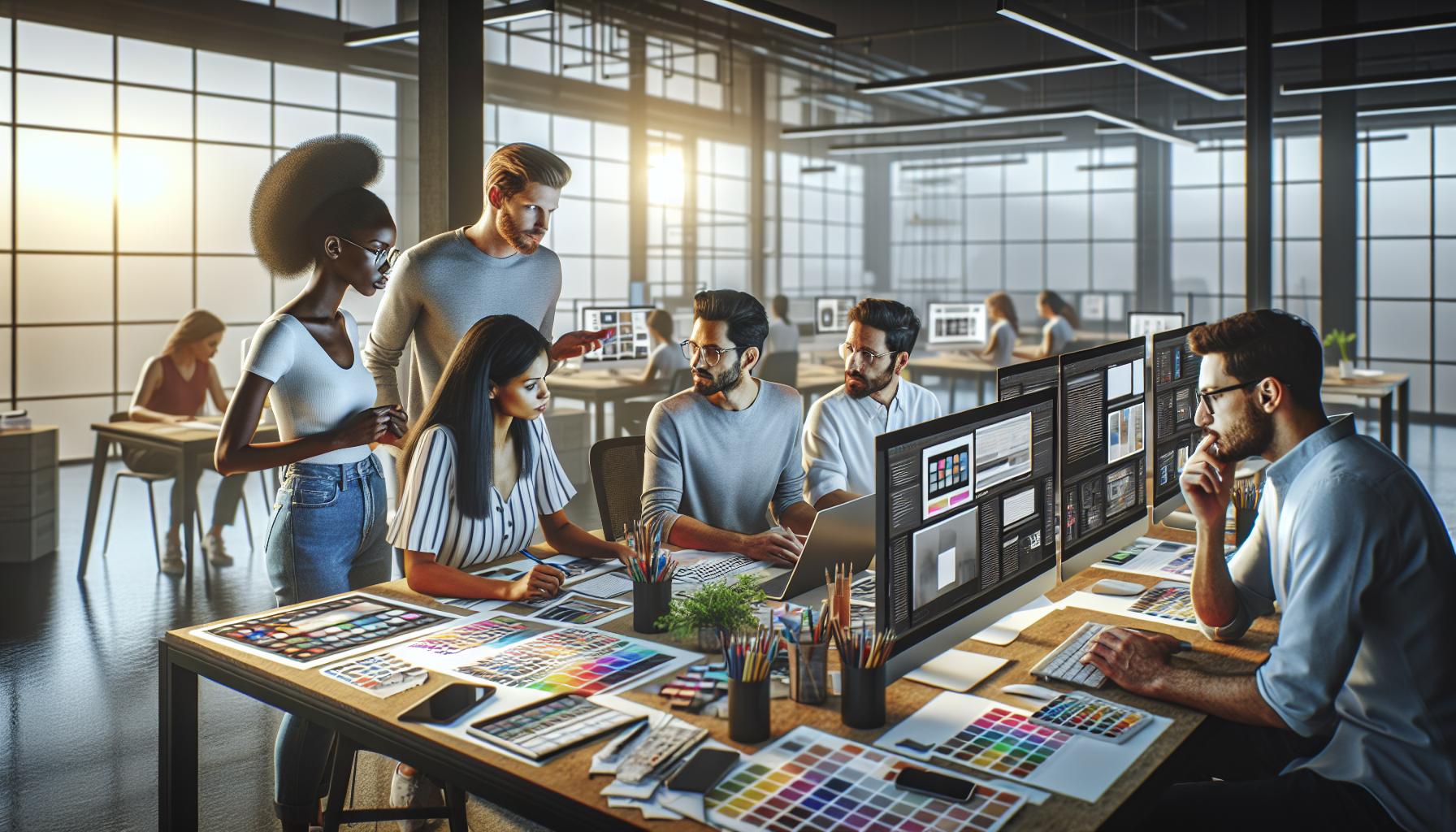In today’s digital landscape, web and design play a crucial role in shaping user experiences and driving engagement. With countless websites vying for attention, the importance of a well-crafted design can’t be overstated. It’s not just about aesthetics; effective web design influences how visitors interact with content and ultimately determines a site’s success.
As technology evolves, so do design trends and techniques. From responsive layouts to minimalist aesthetics, keeping up with the latest developments is essential for anyone looking to stand out online. Understanding the principles of web design can empower businesses and individuals to create visually appealing and functional websites that resonate with their audience.
Key Takeaways
- Importance of Design: Strong web and design are critical for enhancing user experience, driving engagement, and determining a site’s success.
- Responsive Design: Adapting websites for different devices ensures accessibility and improves overall usability, catering to the growing mobile traffic.
- Visual Elements: Effective use of visual hierarchy, color theory, and typography influences user perception and interaction, underscoring the need for a cohesive design.
- Current Trends: Minimalism, responsive layouts, and interactive elements are essential trends that enhance functionality and user engagement in modern web design.
- Continuous Learning: Staying updated with industry trends and honing skills through design software and online learning platforms is vital for success in web design.
Web and Design
Web and design play crucial roles in shaping digital experiences. Effective web design encompasses both visual appeal and functionality, ensuring users engage seamlessly with content. It impacts how visitors perceive a brand, influences conversion rates, and enhances overall usability.
Visual elements such as colors, typography, and imagery contribute significantly to user experience. Integrating responsive design caters to various devices, ensuring accessibility on smartphones, tablets, and desktops. This adaptation provides a consistent experience regardless of screen size.
Moreover, understanding user behavior informs design choices. User experience (UX) research involves analyzing how visitors interact with websites. Such insights lead to optimized navigation, clear calls to action, and improved load times, fulfilling user expectations.
Current design trends emphasize minimalism and simplicity. Utilizing whitespace effectively can enhance visual clarity, highlight essential content, and reduce cognitive load for users. Incorporating interactive elements, such as animations and transitions, can also engage users more effectively.
Staying updated with industry advancements is vital. Following design blogs, attending workshops, and engaging in community forums help professionals refine their skills and adapt to shifts in user preferences. Embracing innovative technologies, such as artificial intelligence and augmented reality, can provide distinct advantages in web design.
Key Elements of Effective Web Design

Effective web design incorporates various elements that enhance usability and aesthetic appeal, creating a seamless experience for users. Key components include visual hierarchy, color theory, and typography.
Visual Hierarchy
Visual hierarchy organizes page elements to guide users’ attention and facilitate navigation. Designers achieve this through size adjustments, contrast variations, and placement strategies. For example, using larger headings creates prominence, while contrasting colors can highlight important buttons. A well-defined visual hierarchy simplifies information processing, aiding users in identifying the most critical elements quickly.
Color Theory
Color theory involves the strategic use of color to evoke emotions and reinforce brand identity. Colors affect user perception and behavior; therefore, selecting a cohesive palette is crucial. For instance, blue often conveys trust, while red can invoke urgency. Color contrast enhances readability and accessibility, enabling users with varying vision capabilities to engage with the content effectively. Implementing the right color combinations ensures an appealing and functional design.
Typography
Typography plays a vital role in establishing brand voice and improving readability. Selecting appropriate fonts involves considering style, weight, and size to ensure compatibility with the overall design. For instance, sans-serif fonts often promote a modern feel, while serif fonts can suggest tradition and reliability. Consistency in font usage—such as limiting the number of typefaces to two or three—enhances clarity and coherence. Proper line spacing and contrast further improve text legibility, allowing users to absorb information effortlessly.
Trends in Web Design

Current trends in web design emphasize functionality, user engagement, and visual clarity. Professionals must adapt to these evolving practices to remain competitive in the digital arena.
Minimalism
Minimalism focuses on simplicity and clarity, stripping away unnecessary elements. This design approach enhances user experience by prioritizing content and functionality. Users can navigate sites more efficiently when distractions are minimized. Effective use of whitespace creates balance, fostering an inviting atmosphere. Examples of minimalistic designs often feature large images, concise text, and a limited color palette that directs user attention strategically.
Responsive Design
Responsive design ensures that websites function smoothly across various devices and screen sizes. It adapts content layout, navigation, and images to maintain usability and aesthetics on desktops, tablets, and smartphones. This adaptability is essential as significant portions of web traffic originate from mobile devices. Techniques such as fluid grids and flexible images facilitate this process, contributing to a seamless user experience that encourages longer visits and higher engagement rates.
Interactive Elements
Interactive elements engage users actively, making websites more dynamic and enjoyable. Incorporating features like hover effects, animations, and quizzes encourages exploration and participation. These elements can increase user retention by providing an immersive experience that resonates with visitors. Examples include interactive infographics, clickable prototypes, and animated transitions, each designed to capture attention and enhance the overall appeal of a website.
Tools and Resources for Web Design

Access to the right tools and resources significantly enhances web design capabilities. Utilizing effective software and online learning platforms streamlines the design process and fosters continuous skill development.
Design Software
Design software transforms ideas into visually compelling websites. The following tools are essential for web designers:
- Adobe XD: Facilitates wireframing and prototyping, making it easy to create and test user interfaces.
- Sketch: Provides vector editing and a suite of tools tailored for user experience and interface design.
- Figma: Enables collaborative design initiatives with real-time editing features for teams.
- Canva: Ideal for beginners, offering a user-friendly interface for creating graphics, layouts, and presentations.
- Webflow: Simplifies the transition from design to development through a no-code platform focused on responsive design.
These tools enhance productivity and ensure that designers can produce high-quality work efficiently.
Online Learning Platforms
Continuous learning is crucial for keeping up with evolving web design trends. The following platforms offer valuable resources and courses:
- Coursera: Features specialized courses from top universities covering web design fundamentals and advanced techniques.
- Udemy: Offers a wide range of courses tailored to different skill levels, focusing on practical skills.
- LinkedIn Learning: Provides video tutorials from industry experts, covering both technical skills and design principles.
- Skillshare: Encourages project-based learning with courses on various design topics, including branding and UX design.
- Codecademy: Focuses on coding skills essential for web designers, offering interactive lessons on HTML, CSS, and JavaScript.
These platforms help designers stay updated and sharpen their skills in an ever-changing industry.
Digital Presence
Web and design are essential components of a successful digital presence. By prioritizing user experience and staying attuned to current trends, designers can create websites that resonate with audiences. The balance between aesthetics and functionality is crucial for driving engagement and enhancing usability.
As the digital landscape evolves, embracing innovative tools and techniques will empower designers to push boundaries and elevate their work. Continuous learning and adaptation are key to maintaining a competitive edge in this dynamic field. Ultimately, effective web design not only captivates users but also fosters lasting connections between brands and their audiences.